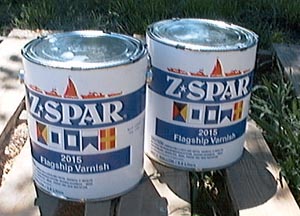Boat Kits:
Boats:
New Ebay Items
Things You'll Need to Complete the Boat:
Further Items You May Want to Add:
Tools You Will Need To Assemble A Boat Kit
Articles:
What comes with a driftboat kit?
What comes with a rowboat kit?
Greg's Online Water Color Gallery
Can I Do It (what skills you need)
How To Order
Other Topics:
Finishes:
Many customers find the choice of finish for their
boat the second most difficult one, after deciding on the
size. The choices are so many in these days of high
technology (the "T" word) that it becomes confusing. The
best choice for you relates to how you store the boat, how
often you use it, how you feel about the final product, and
perhaps, the amount of time you want to dedicate to the
finish, both in the building and down the road. Some
finishes are used in combination with others, further
confusing the issue. We recommend that you take a moment to
discuss all the issues with us upon ordering.
|
Marine Varnish The two Z-Spar varnishes, Helmsman & Flagship, are very high quality. Flagship varnish is more expensive than Helmsman but has six times the UV blocker. That makes Flagship an ideal coating over clear epoxy. Varnish looks the best and its glossy surface makes it easy to keep the boat clean. Three gallons will do most driftboats, or two gallons over epoxy.
Clear Marine Epoxy Epoxy as a wood finish is best used primarily on the plywood parts of the boat. Plywood, even marine plywood, is subject to "checking". Checking in plywood reveals itself as a series of hairline cracks running along the grain of the wood, with the grain fibers pulling apart from each other. This is particularly common when the boat is left out in the weather on a daily basis. Epoxy has the ability to soak farther into the grain than any other finish and inhibit checking. Epoxy should be used on bare wood, which means you should not use a stain underneath it (for color). Epoxy is also an excellent primer under paint. You'll need 2 gallons to coat all the plywood. Click here for a more complete description of our epoxy products. |
 Flagship.....................................Ga.
$100
|
|
Marine Oil Deks Olje #1 (Say "Decks Olya") marine oil is the easiest and fastest finish to apply and redo, but it needs to be attended to more often. It dries to a matte finish. It's at its best in arid climates as more humid climates cause it to mildew. It isn't as good looking as varnish (because it doesn't shine) and it soils more easily. Oil is also useful when applied preceding varnish or paint. It seems to help in the prevention of checking. Two or three gallons will do most boats. Per gallon.......................................Discontinued Unfortunately,
the manufacturer of Deks Olje, the Flood Company has discontinued all
marine products and their marine oil is no longer available. We
are currently looking for a suitable replacement, but in the meantime
here is a popular old-time marine oil recipe that you can make yourself
(feel free to adjust the proportions according to your needs):
|
 |
|
Marine Paint We would like to think that paint is the finish of last resort. That's because we have a natural bias towards seeing the warmth and beauty of wood. One expects such a bias from a wood boat builder. We realize, however, that folks need to store a boat outside sometimes, or perhaps in a guide business, use the boat every day. We'd just say this: you can always paint over oil or varnish if they don't work out, but it is nearly impossible to return to natural wood after the boat is painted. We don't sell paint because it is too hard to carry all the colors our customers desire. If you paint, we recommend a high quality oil based porch and deck enamel. |
Or a Combination! Why not make it really confusing! Not everyone wants to finish their boat with only one type of finish, so why not make it a combination? Many customers have oiled or varnished the inside of their boats and painted the outside. Others have painted the whole hull but varnished the seats, floorboards and fly deck/knee brace. There are as many combinations as reasons for your kids not to eat tofu pate! |
or e-mail at mckenzie@gregboats.com